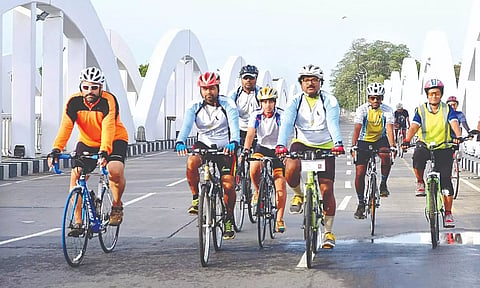

CHENNAI: Did you know that a bicycle ferry once cruised along the tranquil Adyar River, carrying students to their classes at the nascent IIT Madras in 1959? As the prestigious institution’s vast campus was yet to be developed, students living in Saidapet Hostel pedalled to the riverbank, ferrying their bicycles across the waters to reach AC Tech for classes.
Such anecdotes of Madras’ rich water heritage have long been relegated to the annals of time, often forgotten, especially by the younger generation. However, cycling enthusiast and heritage aficionado Ramanujar Moulana aims to revive these stories through his upcoming book, ‘Madras By Cycle - Water Heritage’. The book, currently in the design phase, is set to be unveiled during the Madras Week celebration later this month.
Moulana’s passion for heritage exploration led him to delve into the water-related history of the city.
“Water heritage consists of both built and natural heritage related to water, from canals, reservoirs, waterworks, bridges, to rivers, and lakes,” Moulana explains. His book seeks to connect Madras’ water-related heritage and present it as a source of pride and a catalyst for water conservation.
Every year, Moulana selects different topics to highlight Madras’ heritage. This year, he focused on the city’s water-based history, spanning iconic waterways. “I have done cycling trails like Cooum River Trail, Adyar River Trail, and the Buckingham Canal Trail from Ennore to Edaiyur near Mamallapuram. The book also delves into bridges, water heritage structures such as Kilpauk Water Works and Seven Wells Water Station, and even maritime heritage along the shoreline from Thalankuppam Pier to Mamallapuram Beach,” the cyclist explains.
The book’s pages reveal the significance of water bodies in the city, including lakes, ponds along OMR, and temple tanks like the Kapali Temple Tank, a symbol of the Hindu-Muslim brotherhood.
“Any literature related to water is important. By understanding our past, we can shape a more sustainable future for our city, which heavily relies on the northeast monsoon for its water supply,” he adds.
Moulana’s dedication to research and preserving Madras’ water heritage shines through in his work.
“Apart from my research, I have also sourced information on water bodies from other historians. The book is dedicated to Late Hemachandra Rao, the Buckingham Canal historian,” he concludes.